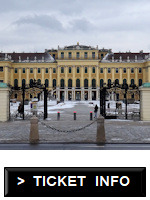Probably the most popular tourist attraction in Vienna: the palace typically pulls in well over two million visitors each year. Think of Schönbrunn as Austria’s Versailles, with slightly less opulence and a lot more cake.
- Huge 18th-century palace, gardens and park
- Now a World Heritage site
- Numerous attractions, including the staterooms, zoo, carriage museum, maze, fountains, VR experience…
- Easily reached from the city centre
- Book a Schönbrunn concert, tour & more*
- See also:
- Hop on hop off buses to Schönbrunn
- Classical concerts in the orangery
To save you some thinking, I have my top ten Schönbrunn activities. But below you’ll find a more detailed overview of almost everything there, with links to articles on each attraction.
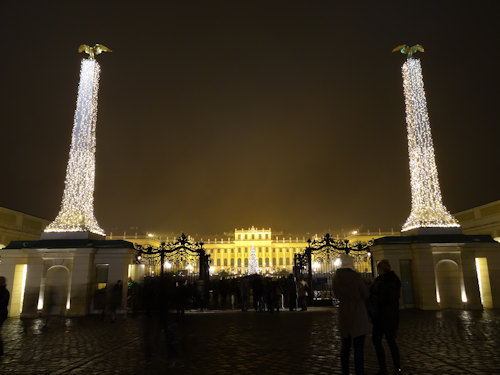
(The main entrance to Schönbrunn at Christmas)
Jump to…
Schönbrunn attractions
Palace & outbuildings…
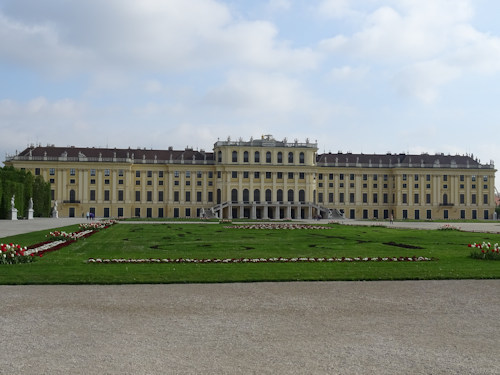
(Schloß Schönbrunn, Wien – the view from the gardens. And, yes, I had to get up very early to get this people-free photo)
The current palace dates back to the 1740s, though a long history of extensions and rebuilding work followed.
Once a summer residence out in the country, the growth of the city now means Schönbrunn represents an oasis of (relative) architectural and parkland tranquility in the midst of 21st-century Vienna.
Palace tours
- Schönbrunn contains hundreds of rooms and you can visit a selection of the most spectacular ones on a palace tour (with self-guided and guided options)
Each room hums with history; follow in the footsteps of Napoleon, Mozart, and even President Kennedy, not to mention a truckload of Habsburg emperors and empresses.
The carriage museum
- A mammoth collection of carriages, sedan chairs, and other modes of transport used by the Imperial family fills the Wagenburg
An exhibition inside also explores the life of Empress Elisabeth (the famous Sisi).
VR experience
- The Schloss Schönbrunn virtual reality experience also takes place within the main palace building
This immersive VR journey focuses more on the history of the Habsburgs, albeit with some palace elements built in.
The Children’s Museum in Schönbrunn Palace
- One wing of the palace now houses a Children’s Museum, which gives youngsters (and accompanying oldsters) a taste of life as a little Archduke or Archduchess
Schönbrunn park & features…
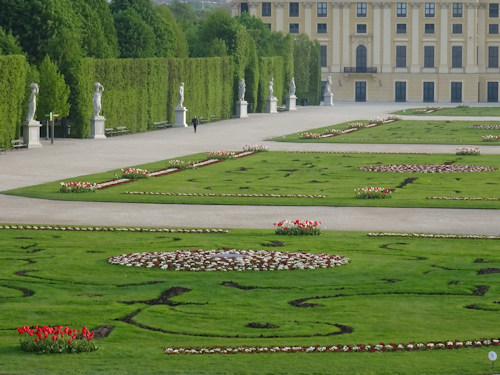
(Schloß Schönbrunn, Wien – part of the landscaped gardens)
The Federal authorities keep the large Schönbrunn park and gardens in immaculate condition, so you can enjoy over a square kilometre of tree-lined avenues, lawns, woods, and landscaped flowerbeds.
Open to the public since 1779, the grounds conceal various architectural delights. Expect fountains, fake ruins, statues, and walled gardens. Look out, also, for red squirrels entirely unconcerned by the crowds.
Incidentally, access to the park and most of the gardens is free. Some of the individual locations mentioned below need a ticket, though.
Some highlights…
The Gloriette
- A large hill stretches behind the palace leading up to the Gloriette
According to legend, they built this triumphal arch simply to ensure a nice view from the windows of the main palace. Indeed, it’s mostly a façade, but with a rooftop viewing platform and a café inside.
The Kronprinzengarten
- The privy garden includes the kind of flowerbeds, box hedges and vine-covered walkways that shout “costume drama” at you
You half expect to meet some 18th-century monarch conducting an illicit affair with a gardener somewhere within.
(Find tickets and experience options for the palace and zoo)
The Schönbrunn orangery
- Not content with native trees, shrubs, and flowers, the Habsburgs put in one of the world’s longest orangeries to add exotic flair to Schönbrunn’s botany
The building and garden now house unusual (for Austria) plants and rare varieties of fruit trees. And a vineyard. Oh, and classical music concerts, which hark back to one of the original uses of the location.
The Schönbrunn maze(s)
- Is it a maze? Is it a labyrinth? Both, I think, because you face more than one hedge-based challenge within the maze complex
The smallest maze is (literally) a walk in the park. The largest is best attempted when you’re not in a hurry. These new mazes build on a long tradition: the first one in Schönbrunn appeared in 1720.
The Roman ruins
- No monarch worthy of the name could have a park without some tasteful Roman ruins within
And if you don’t happen to have any, then you just build some; Schönbrunn’s authentic-looking Roman ruins went up in 1778, modelled on the Temple of Vespasian and Titus.
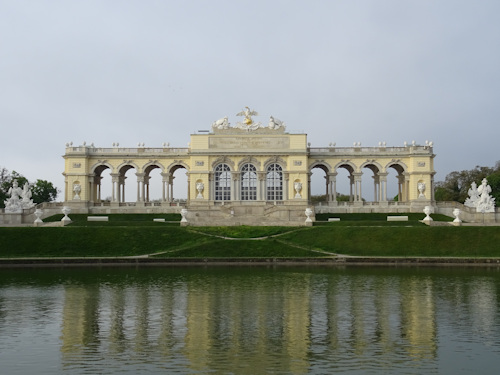
(Schloß Schönbrunn, Wien – the Gloriette)
The obelisk
- Another great civilisation forms the cornerstone of this Schönbrunn highlight: the large obelisk purports to tell the story of the Habsburg dynasty in Egyptian hieroglyphics
The writing is made-up nonsense, but certainly looks impressive (which was always the point with imperial constructions).
The Neptune Fountain
- The Neptune fountain marks one end of the main palace gardens
The most striking of Schönbrunn’s fountains sees the Roman god, Neptune, towering majestically (and a little arrogantly) over tritons and sea horses.
Schönbrunn Zoo area…

(The zoo in Schönbrunn has a pair of giant pandas)
Schönbrunn zoo is the oldest working zoo in the world. Some of the 18th-century buildings from the original menagerie have still survived
The animal enclosures look a little different these days: experts rate the zoo as one of the world’s best. Highlights include the Giant Pandas, the rainforest house, the huge polar bear complex, the aquarium, and the aerial walkway among the wooded slopes.
The zoo is (obviously) great for kids and probably Vienna’s second-most popular attraction after Schönbrunn Palace itself.
The palm and desert houses
Two other indoor locations close to the zoo are…
- The Palmenhaus (palm house), which dates back to 1882. The huge iron and glass construction contains three climatic zones featuring Mediterranean, tropical, and sub-tropical plant communities
- They built the Wüstenhaus (desert house) some 20-odd years later. It has a collection of cacti and succulents, as well as a few birds and animals like the glorious naked mole rats
The Japanese garden
- For something a little different, try the small 1913 Japanese garden sandwiched between the zoo and the palm house
Palace events…
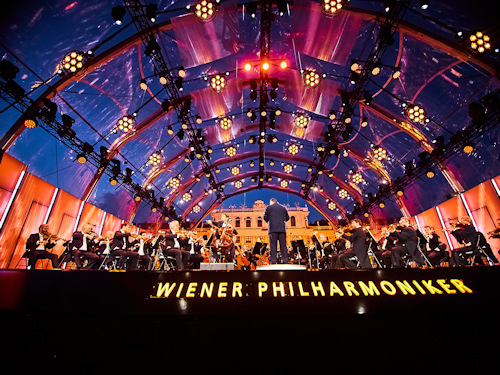
(The Wiener Philharmoniker, Andris Nelsons, and Gautier Capuçon performing at the 2022 Summer Night Concert; press photo © Max Parovsky)
The palace courtyard and buildings make a glorious setting for orchestral performances and other events. For example:
Schönbrunn palace concerts
The palace’s orangery hosts concerts typically featuring the music of Mozart and Strauss. This is not a new invention: Mozart and Salieri, for example, performed for the emperor at the same location.
The Summer Night Concert
The Vienna Philharmonic Orchestra ranks as one of the world’s greatest orchestras. And one of the world’s greatest concert settings is the Schönbrunn Palace landscaped garden.
Put the two together and you probably get a very expensive evening of classical music. Wrong: the annual Summer Night Concert is absolutely free. I went to one and was rather impressed.
Festive Schönbrunn markets
- The Schönbrunn Christmas market has, perhaps, the best ambience of all the city’s many Christmas markets given the location in front of the palace
(Find tickets and experience options for the palace and zoo)
Tickets & visitor tips
The links above take you to specifics on each attraction, including ticket info; you require tickets for the palace tour, orangery, privy garden, gloriette viewing platform, maze, zoo, carriage museum, desert house, palm house and children’s museum.
Various organisations also offer Schönbrunn-related experiences*: guided tours, concerts, wine tasting, a mini-train ride, and more.
The palace staterooms (possibly the most popular tourist activity in Vienna) form the centrepiece of the Schönbrunn complex and require both a tour ticket and a time slot to view.
In summer (and at other peak visitor times), you may have to stand in a long queue on site to get a tour ticket and then wait again until your time slot comes up. So definitely buy online in advance.
I suggest one of the following approaches:
Option 1: Palace tour only
There’s a lot you could see, but the “must see” is the Schönbrunn Palace staterooms. Many people simply wander around the (free) garden and park areas and take a palace tour.
If that’s you, I recommend one of two alternatives.
Guided tour
Go in with a tour guide at a set time, so you skip any queues and have the benefit of an expert accompanying you. For example:
(Booking service provided by Tiqets.com*, who I am an affiliate of)
Self-guided tour
Take one of the standard self-guided tours with the audio guide or printed guide provided by Schönbrunn. I take a deeper look at this option here.
I’d certainly recommend you book your ticket online (see the official website at the bottom of the page) to avoid counter queues and to ensure your time slot fits your trip schedule.
Option 2: Multiple attractions
If you’re planning on seeing more than one attraction, then you can obviously purchase individual tickets (see the articles for details). But two strong options are:
Vienna Pass
This sightseeing ticket gives you one-time free entry to numerous Vienna attractions across 1, 2, 3 or 6 days (see my review for details).
The Vienna Pass also gets you into, for example, the zoo and Carriage Museum, and entitles you to take the self-guided Grand Tour of the palace. But you’ll need to turn up at the Schönbrunn arrival centre and fix a time slot for the tour.
If you do have to wait, then simply make use of the intervening time to visit those other Schönbrunn attractions covered by the pass.
Or simply take in the park and gardens.
Or drop in for cake at one of the cafés.
Combination ticket
If you want to do different activities, but don’t need/want a Vienna Pass, then check the Schönbrunn website for combination tickets.
They offer various choices but all give you savings when compared to buying tickets individually for all the attractions.
Equally, if you don’t buy online and book a tour time in advance, then a combination ticket also lets you spend any waiting time exploring the other Schönbrunn locations.
Option 3: Just the free stuff
The staterooms are brilliant, but you might also just wander around the gorgeous park and gardens. As mentioned, you pay no fee to enter either. In fact, many Viennese go for their early-morning jog in Schönbrunn.
You can easily lose a couple of hours just walking around enjoying the views of the palace, Gloriette, Roman ruins, outbuildings, fountains, obelisk and more.
Spring and summer has the advantage of flowers, while autumn brings out the coloured foliage.
Winter often casts a grey pall over everything, though the park in snow can be a joy. And you have the added bonus of red squirrels, who remain active and regularly make an appearance in the hope of cadging a stray nut or three.
How to get to Schönbrunn
For public transport and parking suggestions, see the Directions to Schönbrunn article. The hop on hop off buses also go out to Schönbrunn.
Address: Schloß Schönbrunn, 1130 Vienna, Austria | Website
